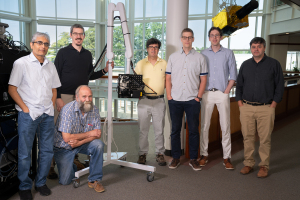by
John R. Fischer, Senior Reporter | August 29, 2023

The NCLUS ultrasound requires no physical contact with the skin. (Photo courtesy of Glen Cooper)
A newly developed laser-based ultrasound enables the solution to image organs, fat, muscle, tendons, blood vessels, to measure bone strength, and possibly to track diseases over time without scans being distorted by movement and compression applied by probes to skin or variability from repeat scans performed by different sonographers.
Researchers at the Massachusetts Institute of Technology Lincoln (MIT) Laboratory teamed up with the Massachusetts General Hospital (MGH) Center for Ultrasound Research and Translation (CURT) to develop the Noncontact Laser Ultrasound (NCLUS), which applies a pulsed laser to the skin and creates ultrasonic waves.
The researchers say that the lack of physical contact could make NCLUS useful for imaging fragile patients and those with painful, sensitive conditions and who are at risk for infections.



Ad Statistics
Times Displayed: 365810
Times Visited: 7093 Quality remanufactured Certified Centrifuges at Great prices! Fully warranted and backed by a company you can trust! Call or click for a free quote today! www.Centrifugestore.com 800-457-7576
The skin feels no sensation during the exam, and ultrasound echoes from the tissue appear as localized vibrations on its surface and are measured by a sensitive, specialized laser Doppler vibrometer.
The system uses a fixed-reference-frame, based on skin markers, to reproduce and compare repeat scans over time, preventing variability. The lab team also developed software to process these scans and detect changes between them, boosting its potential for disease tracking.
The researchers tested a proof-of-concept (GEN-1) system in 2019 but found that its image resolution was less than that of state-of-the-art medical ultrasounds, and that the acquisition time was too long and impractical.
In their clinical system, the laser source and receiver are miniaturized and within an optical head attached to a portable armature that can be positioned with many degrees of freedom to view various anatomical regions. The lasers are 500 times faster than the GEN-1 system, reducing acquisition time to less than a minute; and higher ultrasound frequencies create resolutions of 200 microns, similar to state-of-the-art medical ultrasounds.
The researchers plan to make acquisition times less than one second in future prototypes, and are currently developing systems for military field use, including internal bleeds, musculoskeletal injury monitoring, and elastographic imaging of soft tissue and bone of amputee limb regions for prosthetic designs.
Their next step is to use an operational skin-safe laser in clinical studies to compare NCLUS ultrasound scans to conventional systems. Should those be successful, they plan to seek commercial funding for clinical development, followed by FDA approval.
Back to HCB News

